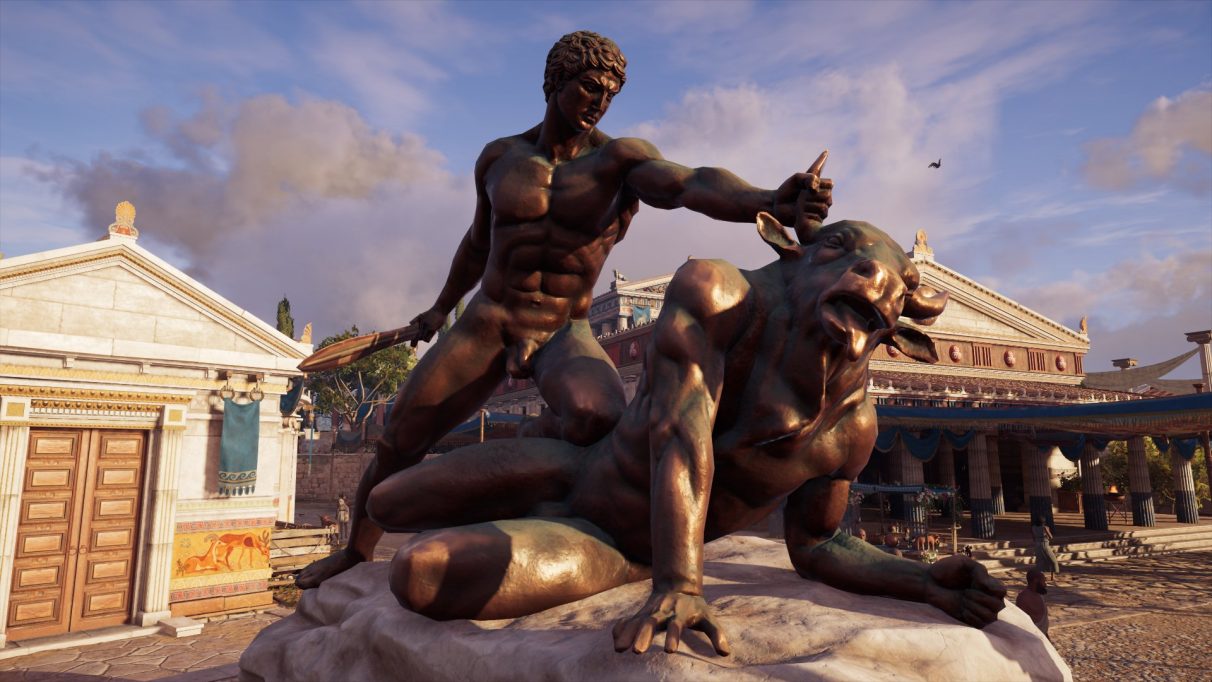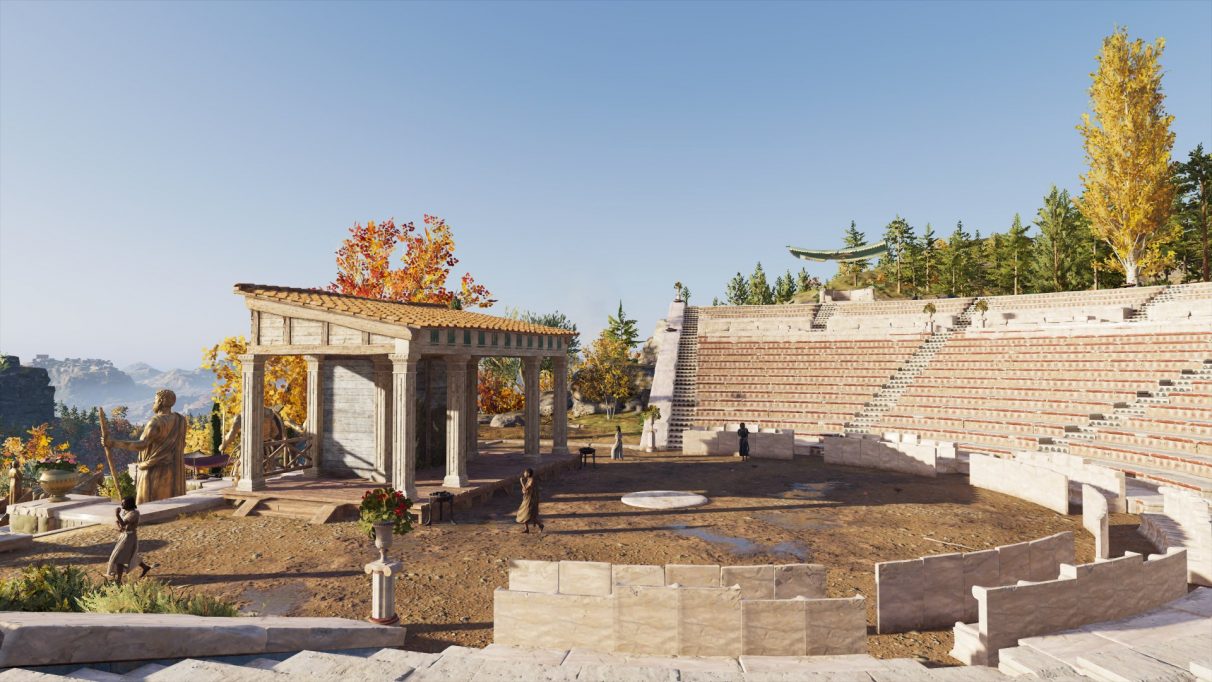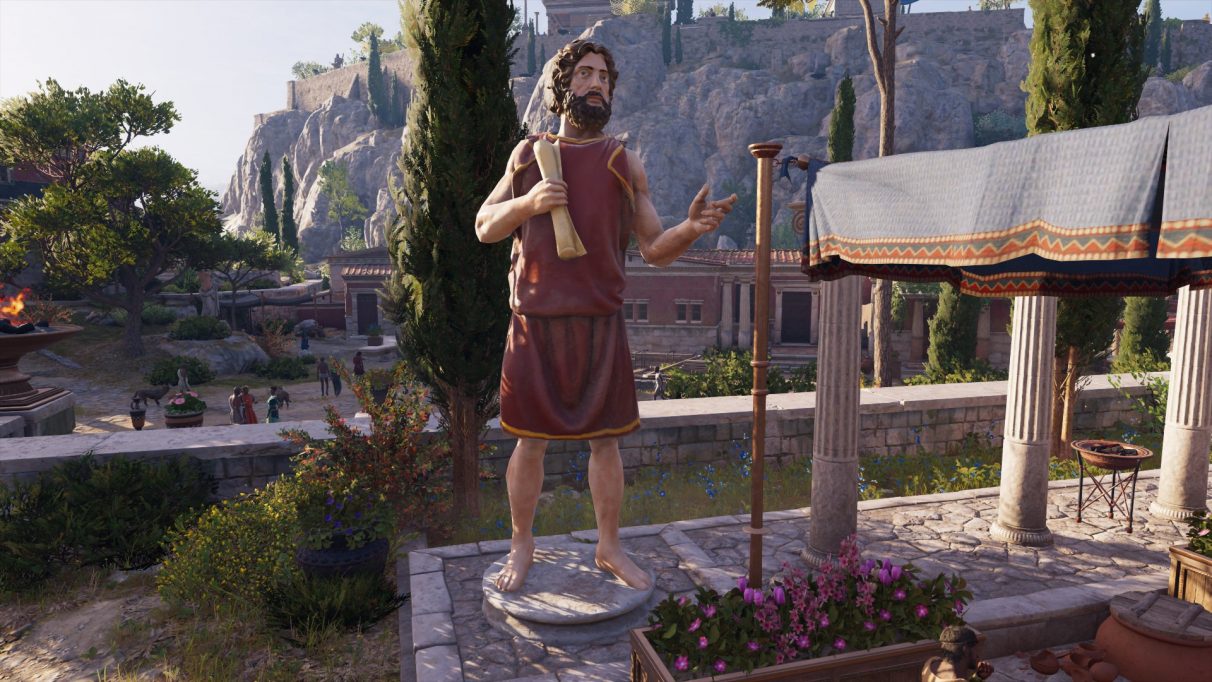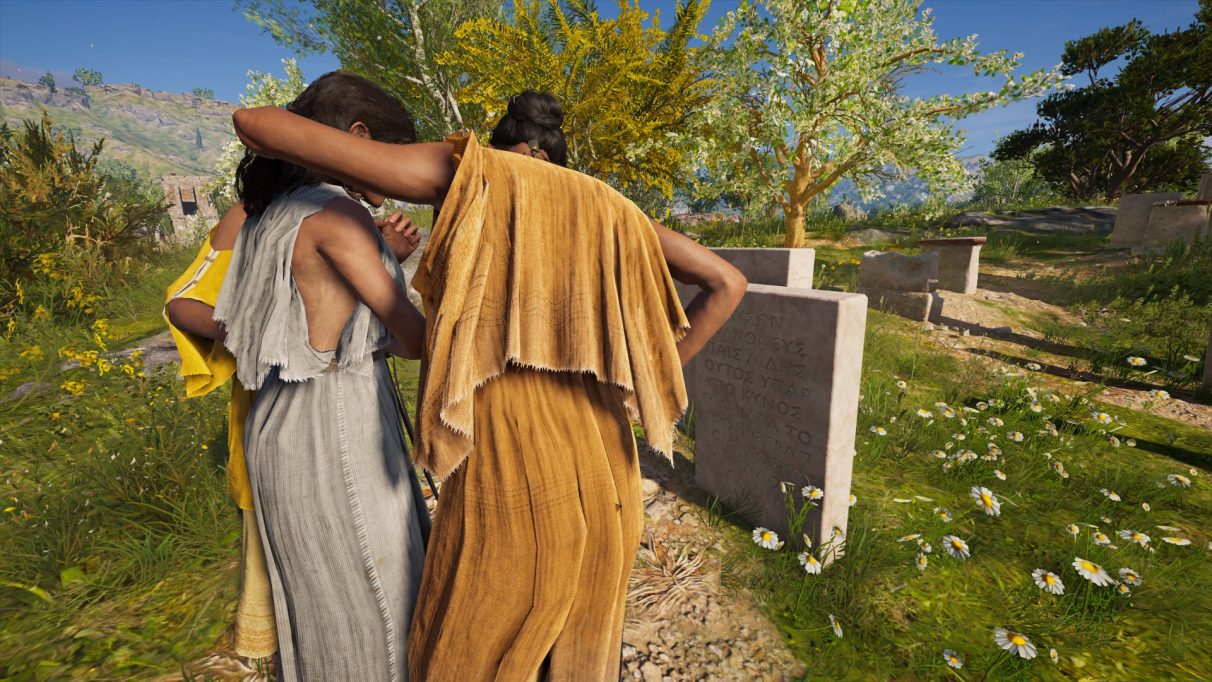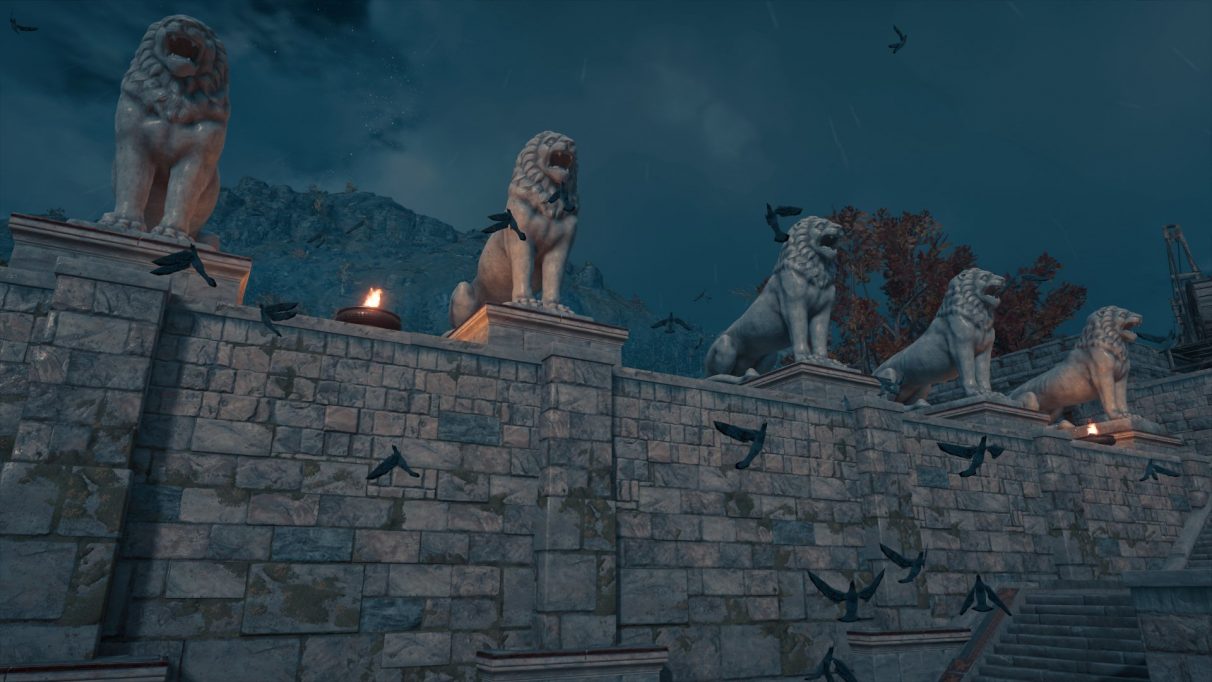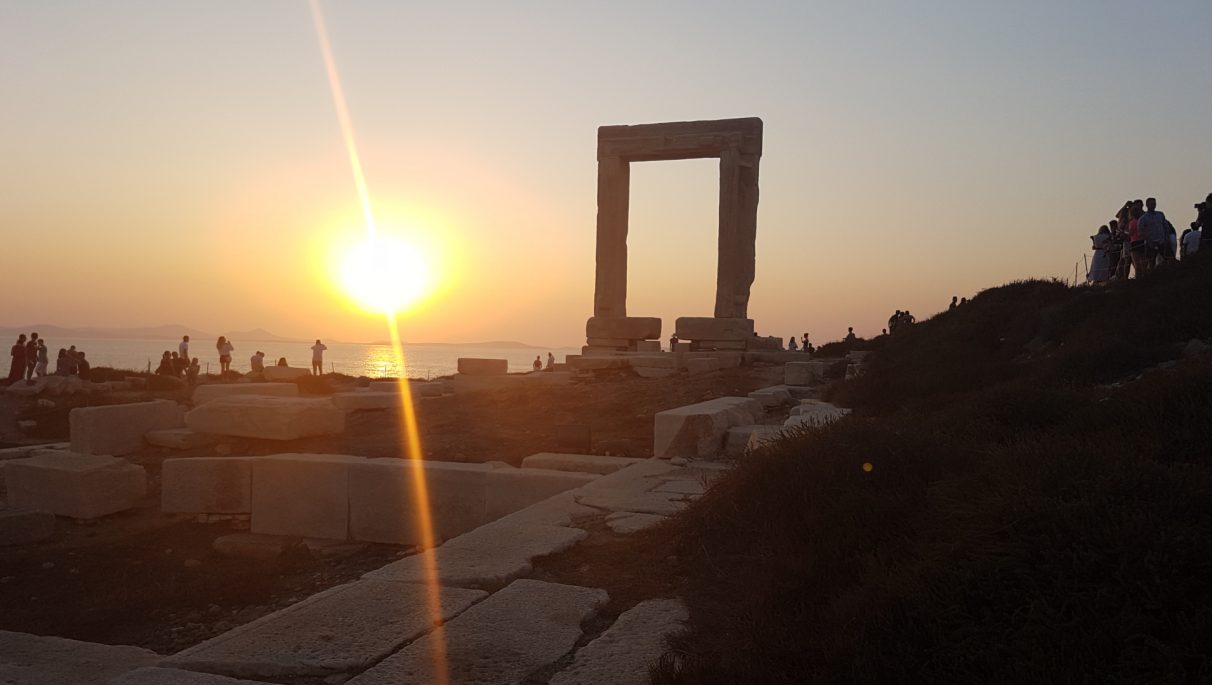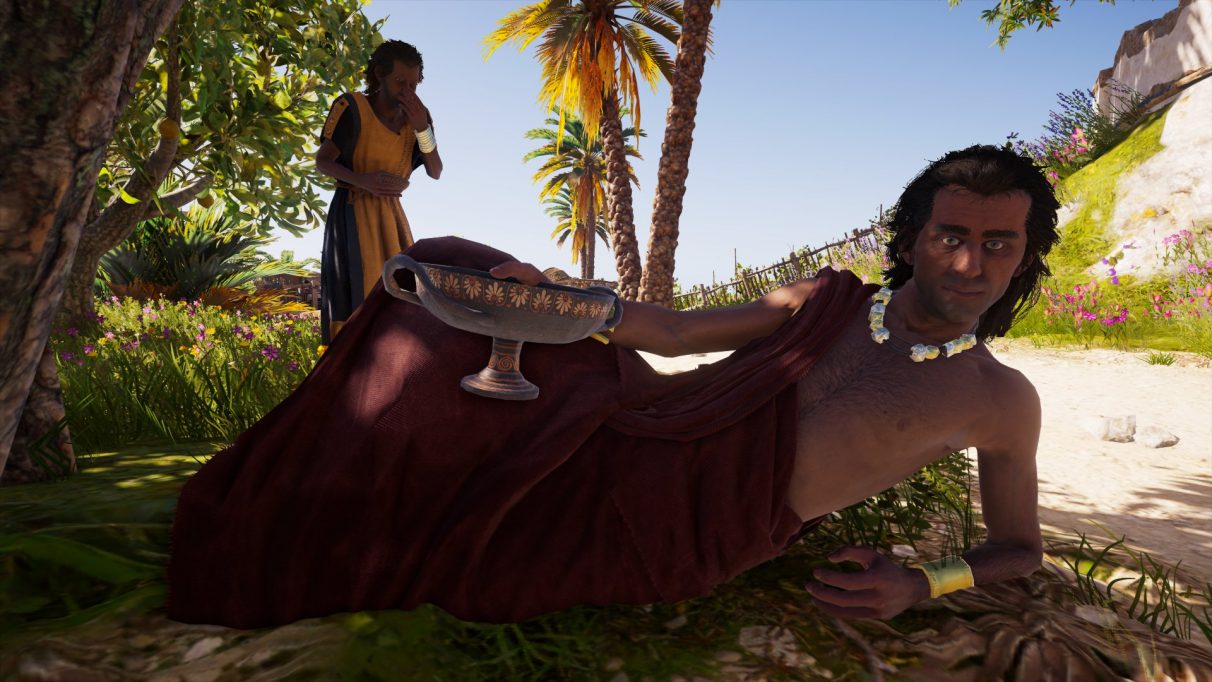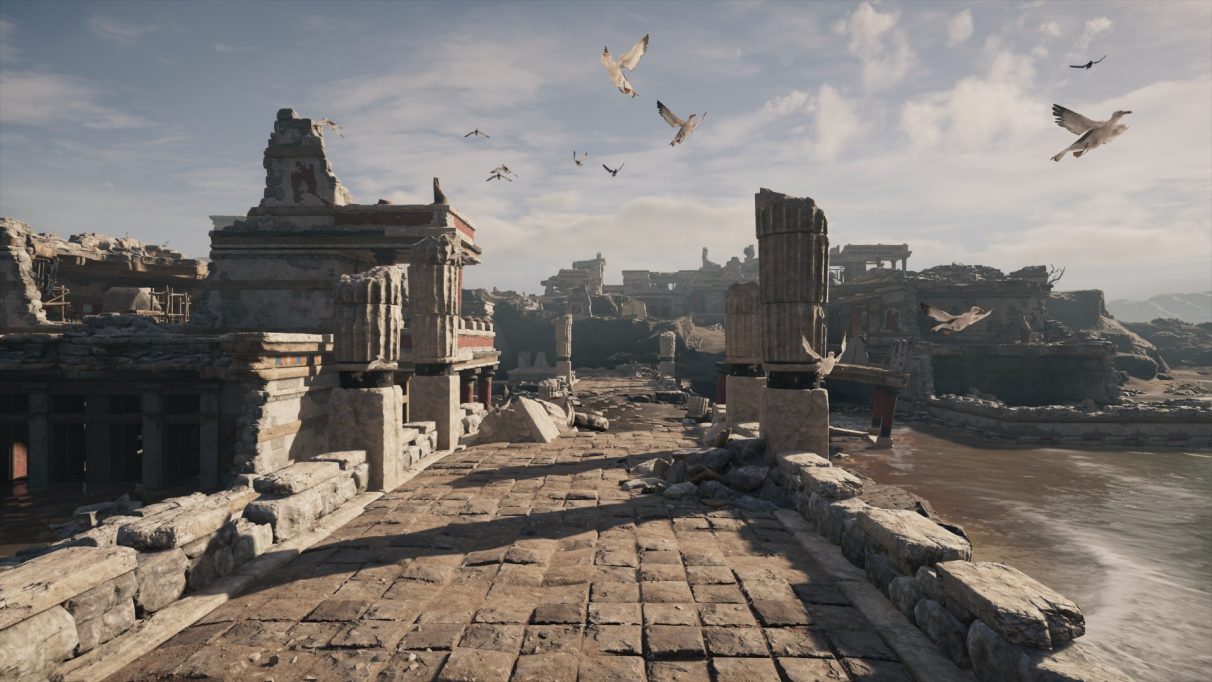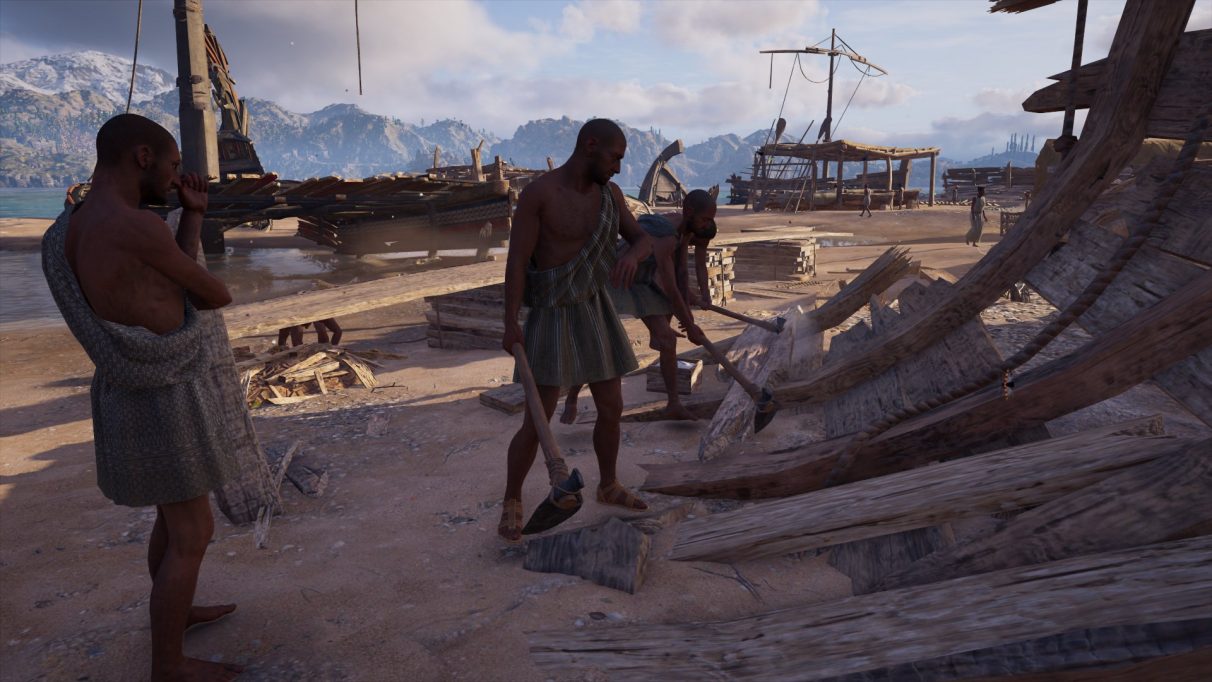Assassin's Creed Odyssey travelogue
Classical photography
Much like its predecessor, Assassin’s Creed Odyssey has snared me with its marvellous camera. With it, I’ve been exploring and snapping Greece, all the way from the Ionian Islands in the west to the Cyclades in the east. I know I should be worrying about wars and parents and magical spears, but that’s all ancillary to the scenes and vignettes playing out on the paved streets and dirt paths that weave across the Hellenic world.
Greece is full of incredible views, epic monuments and, straight away, a huge statue of Zeus dominating the landscape, massive willy hanging out for the world to see. There’s no dearth of things to climb and, more importantly, photograph, but my screenshot folder has even more snapshots of regular life, of people working and partying, or of little bits of striking architecture, especially of the ruined variety.
It’s very tempting to rush through Kephallonia. It’s the ‘starter island’ holding you back from the good stuff, like Athens! That’s what you really want to see, right? Kephallonia is a pretty happening place, though. You should stick around. Aside from having that big ol’ Zeus statue that can be seen even across the sea, there’s also Ithaka, the home of Odysseus. Ah-ha! Odysseus, Odyssey, it all makes sense!
The island of Ithaka has been connected to Homer’s Ithaka since antiquity, though there’s always been some debate about which of the islands in the area actually relate to the ones mentioned by Homer in The Odyssey. Ithaka has been using the name for so long, though, that it seems a bit rude to rock the boat now. Ubisoft’s pretty confident that it’s the right one; so much so that Odysseus’ palace, or at least its ruins, are right there waiting to be explored.
Kephallonia also hosts Greece’s saddest musician. This gloomy fella stood at a muddy, empty crossroads and started mournfully strumming away. I love him. He looks like a tired conman who’s decided to go straight and fall back on his first love: music. There’s definitely a TV show in this, and it absolutely writes itself. We could call it ‘Lyre, Lyre’. This is pure gold.
I had to leave eventually. “Show me Athens,” I said. “No,” replied Odyssey. Instead, I was dragged to Megaris, under siege by the Spartans, followed by Phokis, which is even further away from Athens than Megaris. I’m a big city boy, what can I say? Stepping off the ship, my first impressions of Phokis were… not great.
He’s bold, I’ll give him that. Right out in the open, no wall, not a care in the world. And who am I to judge? I’m standing right behind him taking photos, which is at least as rude, if not more. He’s not representative of Phokis, though, and it’s actually quite nice. It’s best known as the region that contained Delphi, home to Apollo’s oracle. The ruins of the Temple of Apollo persist today and have a nice view of the valley. Even here, in the 5th century BC, the temple is a hot tourist destination, and it’s a bit on the busy side. I searched around for somewhere more serene.
Down the hill from Delphi, there’s a lovely amphitheatre. I wandered into it one morning while it was mostly empty. There were no plays, no speeches, just a couple of people enjoying a morning walk, like myself, and some brightly-coloured birds chirping away. Being the birthplace of theatre, they’re a dime a dozen in Greece, but this amphitheatre had a much more memorable atmosphere, almost contemplative. I give it five stars on Hellenic Tripadvisor.
It was time, finally, to head to Athens. Rather than sailing into the harbour at Piraeus, Odyssey directed me behind Athens, landing on the east coast and then making the rest of the trip on horseback. It’s all for the big reveal, which Ubisoft has become pretty good at pulling off. Arriving this way provides the best views, with the Acropolis and Parthenon looming over the city.
It’s a bustling place, is Athens. It’s not crowded, not in the way that old Assassin’s Creed cities were, which means it’s easier to get around on your horse, but it still feels very busy. Every corner of it is filled with something: a stunning piece of art, a shop, someone just working - turn a corner or pop into someone’s home and you’re bound to find an eye-catching distraction. The statuary in particular is a highlight, and it just keeps on giving.
Odyssey has great statues. The best statues, frankly. You can find them everywhere, but obviously the highest concentration is in the big cities like Athens. And the best part: most of them are painted. The white marble statue is synonymous with the ancient world, particularly Greece and Rome, but we’ve known for a while that most of these statues would have been extremely colourful, like this gesticulating fella. They were gaudy and vibrant, and I’ve always wondered what it must have been like to walk through a city full of them. Lots of fun, it turns out!
While the paint has been worn away by time, tiny particles have persisted and can be revealed under UV light. More techniques can then offer up extra additional details about what it once looked like. Finding out what colour the paints were, for instance, can be done by identifying the ingredients of the paint. If you’re up for some further reading, check out this more detailed explanation of the process.
They aren’t all painted, mind. Here’s Theseus battering the Minotaur, immortalised in bronze. Theseus was an Athenian hero, so of course he gets a nice statue in his hometown. The site of his famous brawl with the bull is far to the south, however, in Crete.
I came across a few workshops, too, where they were being brought to life with chisel and paint, though the largest isn’t in Athens, it’s on the island of Paros. Giant blocks of marble take up most of the docks, while the town is full of half-finished gods, animals and heroes. Right next to the works-in-progress are plenty of finished pieces, ready to be shipped across the sea. It’s fascinating to watch people working away. Their loops and schedules are simple, but there are just so many of them. Alice captured a bunch of them when she went on a tour of Delphi.
Here are some early birds hitting the clay pits just after dawn. The Greek hunger for pottery cannot be sated. I feel a little bit guilty because my splashing around disrupted their work. Sorry!
I spent a long time wandering around Athens and the surrounding area, but the rest of the world was calling to me. To the east were countless islands, and to the south was the Peloponnese, home of the Peloponnesian League and its leader, Sparta. Riding or sailing from Athens, you can hit Korinth, Argo, Sparta and Olympia one after the other, like a grand tour of historically famous Greek city-states.
Greece’s cities are less diverse than ones found in Origins. Ptolemaic Egypt was a melting pot where Roman, Greek and Egyptian culture clashed and mingled. Greek temples faced huge pyramids, while Roman mansions sat just up the road from Egyptian huts. Most of the city-states have a distinct aesthetic, however, and a tone that sets them apart from their allies and foes.
Korinth is particularly gorgeous, in great part thanks to all the blossoming cherry trees that line the streets. Most cities have a colour that they favour, along with the red and blue that shows whether they support Sparta or Athens in the war. Korinth also has an intimidating acropolis that takes ages to clamber up. Akrokorinth is an intimidating rock and the perfect place for a castle, and while it will be turned into a fort in the years following, at this point it’s the site of a temple dedicated to Aphrodite.
These revellers were very into Aphrodite. Look at them go. It’s also slightly tragic, however, for I couldn’t join them. I wanted to, but all I could do was awkwardly shuffle a bit. And duck. That’s not a dance.
In a park on the edge of the city, I came across this pair working on a masterpiece. The light was clearly dying, making it a terrible time for painting, but what do I know? I’m not a painter. I’m sure it will turn out just fine.
Pastimes in Sparta are a little bit different. Its primary industry is generating buff dudes who don’t like clothes, so there’s a real fitness focus. These guys are so determined to work on their muscles that they are completely ignoring the fact that, just behind them, two men have already been devoured by a wolf. You can just make out the blood and a limb or two. Sparta’s a tough place. There’s a war to win, and only the biggest muscles will do.
The Peloponnesian War was one of the defining moments of antiquity and heralded the end of the Golden Age of Greece. Odyssey depicts the war as one between Athens and Sparta, with the rest of the islands and city-states loosely supporting one or the other until a battle makes them change hands. It’s true that the pair led their respective alliances, the Delian League and Peloponnesian League, but that’s where the similarities end. Most of the mainland actually supported Sparta, including the likes of Megaris and Argo, both of which are Athenian in Odyssey. Athens’ power was in its naval empire and its fleet. It wasn’t a neat, symmetrical war, which would pretty much undo Odyssey’s war system.
The effects of the war, and the previous one with Persia, are scattered around the map. Ruined villages, corpses, patrols duking it out by the side of the road - Greece is pretty, but it can be pretty violent, too. This settlement was destroyed by the Persians, and even after their defeat at Salamis and Plataea, ending the Persian War, the empire continued to meddle. They supported Sparta during the Peloponnesian War, then aided Sparta’s ex-allies when they teamed up with Athens to take Sparta down a peg or two a decade later.
Heaped on top of the war are plagues, famines and frontier justice, leaving behind plenty of mourners crying by graves and tombs.
It’s all getting a bit gloomy, so let’s move onto more pleasant things. Like animals! Odyssey has an abundance of critters, and they are all very, very good. Look at this bear, using a road like a person. Isn’t it adorable? Sure, it’s actually chasing me and, five seconds after taking this picture, it knocks me off my horse and kills me. I have no regrets.
I found this good boy running up and down this one stretch of road, splashing in the puddles. That might be all its programmed to do, but I’ve seen dogs happily do this for ages, so I’m convinced this is an accurate simulation of doggy behaviour.
The walls of the Makedonian city of Amphipolis combine my two favourite things: rad statues and cool animals. In 100 years, Alexander the Great will stride out of this kingdom and carve out a huge empire, but it was pretty quiet when I popped over to snap these screenshots. There are plenty of real lions, as well, but I kept forgetting to take a picture as I ran for my life.
Odyssey’s version of mainland Greece takes a long time to explore, but it’s only half of the map. There are islands dotted all over the place, but most of them are in the Aegean. Each of them is this little enigma waiting to be unravelled, spinning stories through quests and obsessively detailed environments.
The first thing you see when you sail into Naxos, an island in the Cyclades, is the Temple of Apollo, which still looks out over the boats today. The temple wasn't completed before the tyrant who commissioned it was overthrown, but for some reason these guys still seem to be trying 70 years after work on it stopped. That’s dedication! It’s a pretty good match for the real temple, to boot.
I took a picture last year, and really the only big difference is all the tourists.
Despite the prominent location of the temple, Dionysus was Naxos’ patron deity, not Apollo, which is pretty obvious after spending only five minutes on the boozy island. I should have taken a video of this fella because nobody has ever pressed grapes so self-consciously before, I’m sure of it. He was so delicate about it, too, making these little hops, followed by furtive glances. It was very odd, but also utterly captivating.
Dionysus was the god of wine, but he was also the god of being a total dick. Our Minotaur-murdering pal Theseus ended up on the island after escaping Crete with Ariadne. In some versions of the myth, Theseus, being a total dick himself, simply abandons Ariadne, while others say Dionysus forced him to leave without her. Either way, this hairy, drunk god finds this heartbroken woman and promptly marries her. Gods are shady. Then there was the time when he killed his cousin who, in fairness, was also a dick. It’s a theme. Pentheus was spying on one of Dionysus’ parties when the god appeared, drove his followers mad and then watched as they ripped him limb from limb, believing him to be a lion. His own mother ripped his head right off. Crikey.
It’s the middle of the day when I start exploring Naxos, but people are already knocking back the bowls of wine. Underneath a tree I see some tipsy couples canoodling, but also this solitary hunk. If it wasn’t for the guy about to throw up behind him, this would be sexy calendar material. You’ll find someone to canoodle with one day, guy!
Each island has something that makes it special. Even if it’s just a man camping with his best friend, a goat.
Or this haunted Minoan ruin that seems to be protected by scary cats. You can't see them, but they're lurking in the shadows, waiting to chase me off again.
Given the size of the thing, it’s ridiculous that there so many discrete, thoughtfully crafted areas that you might only spend five minutes in, if any time at all. On the north coast of the Peloponnese are countless shipwrecks. I sailed by and it piqued my interest, so I dropped anchor and swam over. There were some quests there, but I hadn’t been directed to the spot. It’s a massive ship graveyard that’s been transformed into a town. Homes have been built out of the wrecks, while scavengers work up and down the beach, prying wood from the dead ships. I could fill a whole album just with the screenshots I took there alone.
I’m not quite done with it. Odyssey is so much bigger than its story, and there are so many places where I rushed through on my way somewhere else or haven't visited at all. Like Origins, a Discovery Mode is in the works, taking you on guided tours on Greece, but there’s something to be said for just aimlessly wandering across the map. It’s one of the most impressive spaces Ubisoft’s ever created, and even without the historical context or narration, it’s just an amazing thing to look at.



